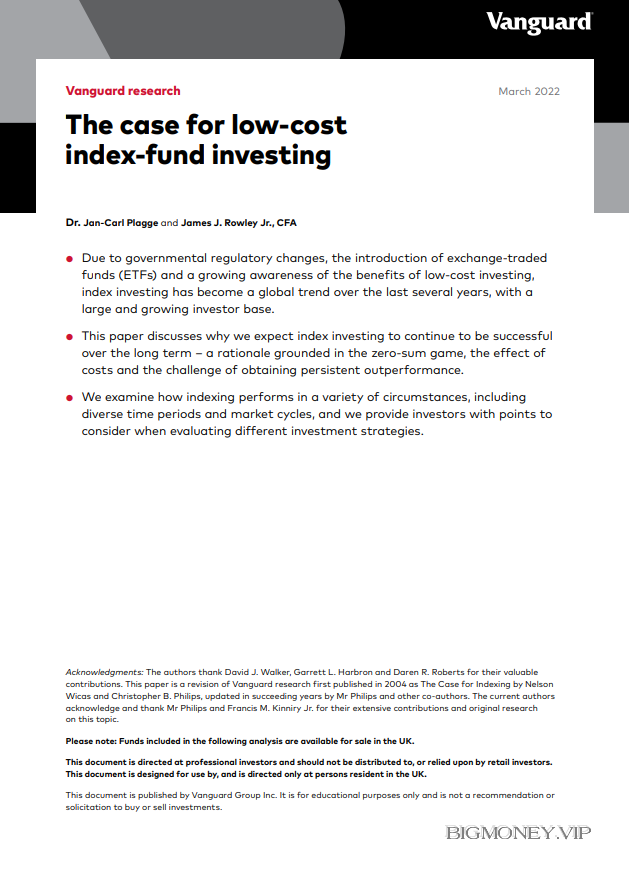The case for low-cost index-fund investing by Dr. Jan-Carl Plagge and James J. Rowley Jr., CFA

Index investing was first made broadly available
to US investors with the launch of the first indexed
mutual fund in 1976. Since then, low-cost index
investing has proven to be a successful investment
strategy over the long term, outperforming the
majority of active managers across markets and
asset styles (S&P Dow Jones Indices, 2015). In part
because of this long-term outperformance, index
investing has seen exponential growth among
investors, particularly in the United States, and
especially since the global financial crisis of 2007–
2009. In recent years, governmental regulatory
changes, the introduction of indexed ETFs and a
growing awareness of the benefits of low-cost
investing in multiple world markets have made index
investing a global trend. This paper reviews the
conceptual and theoretical underpinnings of index
investing’s ascendancy (along with supporting
quantitative data) and discusses why we expect
index investing to continue to be successful and to
increase in popularity in the foreseeable future.
A market-capitalisation-weighted indexed
investment strategy – via a mutual fund or an
ETF, for example – seeks to track the returns of a
market or market segment with minimal expected
deviations (and, by extension, no positive excess
return) before costs, by assembling a portfolio
that invests in the securities, or a sampling of the
securities, that comprise the market. In contrast,
actively managed funds seek to achieve a return or
risk level that differs from that of a market-cap-
weighted benchmark. Any strategy, in fact, that
aims to differentiate itself from a market-cap-
weighted benchmark (e.g., “alternative indexing”,
“smart beta” or “factor strategies”) is, in our view,
active management and should be evaluated based
on the success of the differentiation.
This paper presents the case for low-cost index-
fund investing by reviewing the main drivers of its
efficacy. These include the zero-sum game theory,
the effect of costs and the difficulty of finding
persistent outperformance among active managers.
In addition, we review circumstances under which
this case may appear less or more compelling than
theory would suggest, and we provide suggestions
for selecting an active manager for investors who
still prefer active management or for whom no
viable low-cost indexed option is available.
Notes on risk and performance data:
Investments are subject to market risk, including the possible loss of the money you invest. Bond funds
are subject to the risk that an issuer will fail to make payments on time, and that bond prices will
decline because of rising interest rates or negative perceptions of an issuer’s ability to make payments.
Diversification does not ensure a profit or protect against a loss in a declining market. Performance
data shown represent past performance, which is not a guarantee of future results. Note that
hypothetical illustrations are not exact representations of any particular investment, as you cannot
invest directly in an index or fund-group average.
Zero-sum game theory
The central concept underlying the case for index-
fund investing is that of the zero-sum game.
This theory states that, at any given time, the
market consists of the cumulative holdings of all
investors, and that the aggregate market return
is equal to the asset-weighted return of all market
participants. Since the market return represents
the average return of all investors, for each position
that outperforms the market, there must be a
position that underperforms the market by the
same amount, such that, in aggregate, the excess
return of all invested assets equals zero. Note
that this concept does not depend on any degree
of market efficiency; the zero-sum game applies to
markets thought to be less efficient (such as small-
cap and emerging market equities) as readily as
to those widely regarded as efficient (Waring and
Siegel, 2005).
Figure 1 illustrates the concept of the zero-sum
game. The returns of the holdings in a market form
a bell curve, with a distribution of returns around
the mean, which is the market return.
It may seem counterintuitive that the zero-sum
game would apply in inefficient markets, because,
by definition, an inefficient market will have more
price and informational inefficiencies and, therefore,
more opportunities for outperformance. Although
this may be true to a certain extent, it is important
to remember that for every profitable trade an
investor makes, (an)other investor(s) must take the
opposite side of that trade and incur an equal loss.
This holds true regardless of whether the security
in question is mispriced or not. For the same
reason, the zero-sum game must apply regardless
of market direction, including bear markets, where
active management is often thought to have
an advantage. In a bear market, if a manager is
selling out of an investment to position the portfolio
more defensively, another or others must take the
other side of that trade, and the zero-sum game
still applies. The same logic applies in any other
market, as well.
Some investors may still find active management
appealing, as it seemingly would provide an even-odds
chance of successfully outperforming. As we discuss
in the next section, though, the costs of investing make
outperforming the market significantly more difficult
than the gross-return distribution would imply.
Effect of costs
The zero-sum game discussed here describes a
theoretical cost-free market. In reality, however,
investors are subject to costs to participate in the
market. These costs include management fees,
bid-ask spreads, administrative costs, commissions,
market impact and, where applicable, taxes – all of
which can be significant and reduce investors’ net
returns over time. The aggregate result of these
costs shifts the return distribution to the left.
The case for low-cost index-fund investing by Dr. Jan-Carl Plagge and James J. Rowley Jr., CFA




